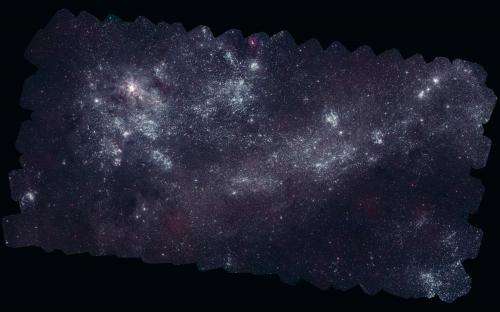Swift gamma-ray burst mission marks ten years of discovery

(Phys.org) —NASA's Swift spacecraft lifted off aboard a Boeing Delta II rocket from Cape Canaveral Air Force Station, Fla., beginning its mission to study gamma-ray bursts and identify their origins. Gamma-ray bursts are the most luminous explosions in the cosmos. Most are thought to be triggered when the core of a massive star runs out of nuclear fuel, collapses under its own weight, and forms a black hole. The black hole then drives jets of particles that drill all the way through the collapsing star and erupt into space at nearly the speed of light.
Astronomers at NASA and Pennsylvania State University used Swift to create the most detailed ultraviolet light surveys ever of the Large and Small Magellanic Clouds, the two closest major galaxies. Nearly a million ultraviolet sources appear in this mosaic of the Large Magellanic Cloud, which was assembled from 2,200 images taken by Swift's Ultraviolet/Optical Telescope (UVOT) and released on June 3, 2013. The 160-megapixel image required a cumulative exposure of 5.4 days. The image includes light from 1,600 to 3,300 angstroms—UV wavelengths largely blocked by Earth's atmosphere—and has an angular resolution of 2.5 arcseconds at full size. The Large Magellanic Cloud is about 14,000 light-years across.
Viewing in the ultraviolet allows astronomers to suppress the light of normal stars like the sun, which are not very bright at such higher energies, and provides a clearer picture of the hottest stars and star-formation regions. No telescope other than UVOT can produce such high-resolution wide-field multicolor surveys in the ultraviolet.
Pennsylvania State University manages the Swift Mission Operations Center, which controls Swift's science and flight operations. Goddard manages Swift, which was launched in November 2004. The satellite is operated in collaboration with Penn State, the Los Alamos National Laboratory in New Mexico and Orbital Sciences Corp. in Dulles, Va. International collaborators are in the United Kingdom and Italy, and the mission includes contributions from Germany and Japan.
Provided by NASA





















